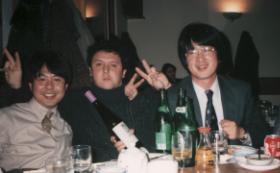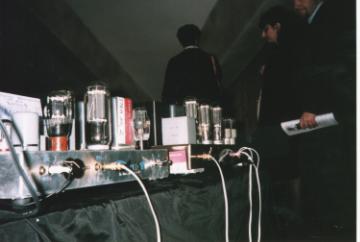Black fog; and then suddenly there appear the many lights of Milano. The illumination is softened and made gentle by the mist.
Gentle too, are the Italian friends we find at the airport.
We set up our amplifiers, speakers and DAT player in the listening room of "Hi-Fi Clinic Donzelli".
At first we think the hall is too small for a big sound, but soon we find means to avoid trouble from the reflected sounds. We open the skylights in the roof.
There are 300 audiophiles attending our audio concerts over these two days. They have arrived from Milano, Palma, Soncino, Bologna and Roma.
Two years ago we had only fifty audiophiles at our audio concert. I wonder if the sound of Mr. Sakuma (and his name) has not become well known since our last visit.
Naturally, Italian audiophiles have not been preoccupied only with Mr. Sakuma, but also with amateur Japanese hand-made audio. Many Italian audiophiles desire to subscribe to "MJ Musen to Jikken".
At Japanese audio concerts, listeners sit down in their seats in silence; like at a live music concert. In Italy, the visitors listen to the music standing, and walk over to look at the Sakuma system while asking Mr. Sakuma questions about his amplifier.
When Mr. Sakuma receives questions he responds by playing plays music through his amplifier.
"This sound is characteristic of this amplifier. To get this sound I have employed unique ideas. Please, do examine this schematic". By this explanation he substitutes his fluency in sound for poor italian.
Some people bring their personal CD to try on the Sakuma system. Even if Mr. Sakuma has never heard their CD, he selects the best combination of his amplifiers.
When an Italian audiophile shouts "You're great!" in response to Mr. Sakuma's performance, we gain another good friend in Italy.
We have brought the 801A driver / 845 push-pull phono preamp and the 845 driver / 845 push-pull power amplifier. And one more; a new amplifier. This amplifier consists of three units: A V V30B driver / V V52B SE; a V V30B one-tube unit and a WE350B one-tube unit. By changing the combination of these units we can obtain by simple means, the best sound from the CD.
Many visitors are professional engineers. Naturally, they want to understand this complex amplifier.
After many questions one of these men has become so comfortable with the design that he says to a newly arrived visitor "Thank you for coming, sir". He asks "Do you have any questions about this amplifier?" (He seems to have become a member of our Direct Heating team) He continues: "Do you need my "technical" explanation?".
Then the engineer gives a perfect explanation, and we know to expect some new Italian members at our dinner table.
Some groups discuss a Sakuma system like this: "Mono systems are the best method for realistic music reproduction." "No, we must go with a stereo system." "Why? do you think Sakuma Sound is no good?" "It's because we can't make Sakuma sound, so we choose instead a stereo system, which we can make.
Indeed, in Italy it is difficult to get electronic parts for audio. It is difficult to find tubes. Even European tubes like the PX4, which are very well known to the Japanese are not very available.. Exceptional quality transformers are very high in cost. For Italian audiophiles it is not easy to build amplifiers described in "MJ".

Left to right
Takuji, Mr Donzelli: owner of the hall and Goto
Here is a young man who desires some advice from Mr. Sakuma. He has learned the Sakuma method by reading "Remembrance of Sound Past".
He finds he can't get many of the parts which Mr. Sakuma used. He needs to substitute parts.
"Can I substitute the Tamura transformer with one of European make? Can I change this triode for another type?"
This young man is but 23 years old. He has played his mono system in his apartment for two years now.
Of course, Mr. Sakuma knows these changes will change the sound of the amplifier. He chooses to reply, with a gentle tone, "No problem".
He doesn't require that the young man make a completely similar amplifier. He desires that the young man find his own sound by the Sakuma method.
Italians audiophiles have listening skills learned by listening to the sound of many live music concerts. They have knowledge of electronics and they have the technique to make amplifiers.
I view their abilities and knowledge as more excellent than that of the Japanese. Their feelings of art and strength of knowledge will combine to make a good, new system of audio. So we regret even more their difficulty in gathering correct parts.

Sakuma sound excites some people. To silence the attendants of the audio concert, Mr. Sakuma brings out the "tuba" sound system. This unique system comprises a small compression driver unit and the musical instrument, the tuba. The tuba, and an amplfier of merely a few watts creates a tender and nostalgic sound. The listeners stop moving about. They are transfixed, and we can see their heartfelt emotion.
This magical tuba sound is the message from Mr. Sakuma.
Japanese and Italians hold the love of nature foremost in their imagination.
Our Japanese nature is colorful, but our Japanese spirit is mono-tone; like the art of Kanji and the tuba's small range of notes.
We condense colorful nature into simple and monotone art. In my view, Italians living in this misty city of monotones sense many messages in simple sounds.
To impress the soul, or to impress the deepest memory, the best means is not some authoritative speech. Far better is a whisper; like the mother, gentle to her baby.
The Tuba sound is Sakuma's whisper.
In the midnight we walk through the city of Milano. The buildings and road are made of hard stone. Our voices and footsteps reflect from stone walls.
Suddenly I hear a sound that I have heard before, at Japan's oldest temple- "Chuguji".
The path to Chuguji is covered in many small white pebbles. When I walk that temple path in the evening I listen to the mystical sound. Its tone goes down into the white pebbles without reflection.
The sound of Italy goes wide into space.
Japanese sounds permeate to the underground.
The memory of Japanese amplifiers permeates into Italian hearts. The memory of Italian art, Italian music and our Italian friends reflects in our hearts.
Harking to these sounds, we say to our friends
"Thank you so very much.
We shall come back soon".
